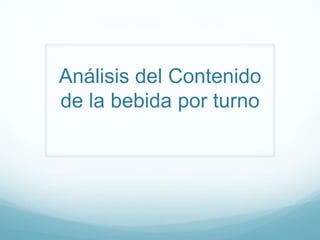Denunciar
Compartir

Recomendados
Más contenido relacionado
Destacado
Destacado (20)
Product Design Trends in 2024 | Teenage Engineerings

Product Design Trends in 2024 | Teenage Engineerings
How Race, Age and Gender Shape Attitudes Towards Mental Health

How Race, Age and Gender Shape Attitudes Towards Mental Health
AI Trends in Creative Operations 2024 by Artwork Flow.pdf

AI Trends in Creative Operations 2024 by Artwork Flow.pdf
Content Methodology: A Best Practices Report (Webinar)

Content Methodology: A Best Practices Report (Webinar)
How to Prepare For a Successful Job Search for 2024

How to Prepare For a Successful Job Search for 2024
Social Media Marketing Trends 2024 // The Global Indie Insights

Social Media Marketing Trends 2024 // The Global Indie Insights
Trends In Paid Search: Navigating The Digital Landscape In 2024

Trends In Paid Search: Navigating The Digital Landscape In 2024
5 Public speaking tips from TED - Visualized summary

5 Public speaking tips from TED - Visualized summary
Google's Just Not That Into You: Understanding Core Updates & Search Intent

Google's Just Not That Into You: Understanding Core Updates & Search Intent
The six step guide to practical project management

The six step guide to practical project management
Beginners Guide to TikTok for Search - Rachel Pearson - We are Tilt __ Bright...

Beginners Guide to TikTok for Search - Rachel Pearson - We are Tilt __ Bright...
Fercho diseño
- 1. Análisis del Contenido de la bebida por turno
- 2. Distribución del Contenido de la Bebida en Turno 1 Con p= 0,177 no se rechaza Ho. La distribución del contenido de la bebida en turno 1 es normal.
- 3. Distribución del Contenido de la Bebida en Turno 2 Con p= 0,145 no se rechaza Ho. La distribución del contenido de la bebida en turno 2 es normal.
- 4. Medidas de tendencia central Para ambos turnos se considera la media como medida de tendencia central. La media se estima a través del promedio Turno1: 500,60 ml Turno 2: 499,83 ml
- 5. Análisis Turno 2. Con p= 0,692 no se rechaza Ho. La media del turno de la tarde es menor o igual a 500. La jefatura tiene una percepción incorrecta sobre el contenido de la bebida en dicho T de una muestra: Bebida 2 turno. Prueba de mu = 500 vs. > 500 Error estándar de la 95% Límite Variable N Media Desv.Est. media inferior T P Bebida 2 45 499,831 2,250 0,335 499,267 -0,50 0,692
- 6. Diferencias Significativas entre los turnos Prueba T e IC de dos muestras: Bebida 1; Bebida 2 T de dos muestras para Bebida 1 vs. Bebida 2 Error estándar de la N Media Desv.Est. media Bebida 1 45 500,60 4,79 0,71 Bebida 2 45 499,83 2,25 0,34 Diferencia = mu (Bebida 1) - mu (Bebida 2) Estimado de la diferencia: 0,769 IC de 95% para la diferencia: (-0,807; 2,345) Prueba T de diferencia = 0 (vs. no =): Valor T = 0,98 Valor P = 0,333 GL = 62 Gráfica de caja de Bebida 1; Bebida 2 Con p=0,33 existe suficiente evidencia estadística para no rechazar Ho. Se mantiene el hecho que la media del contenido de la bebida en t1 no difiere significativamente de la media del contenido de la bebida en turno 2. El turno no tiene influencia en el contenido de la bebida.
